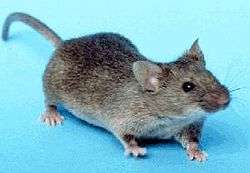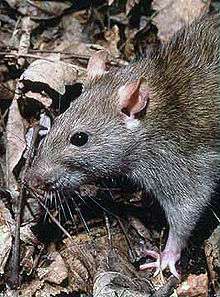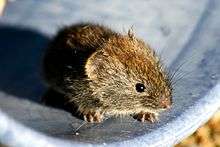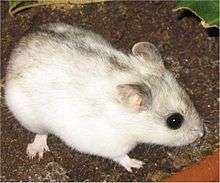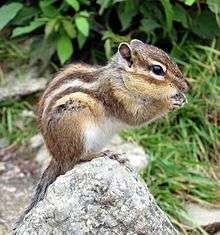List of mammals of Korea
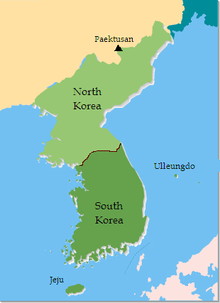

Approximately 100 species of mammal are known to inhabit, or to have recently inhabited, the Korean Peninsula and its surrounding waters. This includes a few species that were introduced in the 20th century; the coypu was introduced for farming in the 1990s, and the muskrat was introduced in the early 20th century into the Russian Far East and was subsequently first recorded in Korea in the Tumen River basin in 1965. The Siberian tiger and Japanese sea lion have probably been extirpated from Korea, but are still included in standard lists of Korean mammals.
Most Korean mammal species are found only in a small part of Korea. The large southeastern island of Jeju, and the rugged northeastern Paektu Mountain region, are particularly known for their distinctive mammal species. Several species, including the Dsinezumi shrew, are found only on Jeju, while many other species, such as the wild boar, are absent or extirpated from there. Some mammals, such as the Manchurian wapiti, are considered natural monuments of North Korea, while others, such as the spotted seal, are considered natural monuments of South Korea.
Order Artiodactyla: even-toed ungulates
| Common name
(Korean name) |
Species
(authority) |
Preferred habitat | Range | Status[1] |
|---|---|---|---|---|
| Family Bovidae: bovids | ||||
| Long-tailed goral
|
Naemorhedus caudatus[2] (Hamilton Smith, 1827) |
High mountains | Northern Taebaek Mountains, including the Demilitarized Zone.[3] |
|
| Family Cervidae: deer | ||||
| Siberian roe deer
|
Capreolus pygargus (Pallas, 1771) |
Forest verges | Throughout; not found on Ulleungdo |
|
| Manchurian wapiti
|
Cervus c. xanthopygus (Erxleben, 1777) |
Forest verges | North Hamgyong and the Paektusan region |
|
| Manchurian sika deer
|
Cervus n. mantchuricus (Temminck, 1838) |
Open forests and forest verges | Throughout mainland[12] |
|
| Water deer
|
Hydropotes inermis (Swinhoe, 1870) |
Low mountains and riparian areas | Throughout mainland |
|
| Family Suidae: pigs | ||||
| Wild boar
|
Sus s. ussuricus (Linnaeus, 1758) |
Mountain forests | Throughout mainland |
|
| Family Moschidae: musk deer | ||||
| Siberian musk deer
|
Moschus moschiferus (Linnaeus, 1758) |
Mountain forests | North Korea; also found in Gangwon, South Korea |
|
Order Carnivora: carnivores
| Common name
(Korean name) |
Species
(authority) |
Preferred habitat | Range | Status[1] |
|---|---|---|---|---|
| Family Canidae: canids | ||||
| Eurasian wolf
|
Canis lupus (Linnaeus, 1758) |
Forests and open woods | Paektu Mountain area | |
| Dhole
|
Cuon alpinus[23] (Pallas, 1811) |
Dense forests and high mountains | Paektu Mountain area |
|
| Raccoon dog
|
Nyctereutes procyonoides (Gray, 1834) |
Wooded valleys | Throughout mainland |
|
| Red fox
|
Vulpes vulpes (Linnaeus, 1758) |
Brushy areas and forest verges | Northern and northeastern Korea | |
| Family Felidae: felids | ||||
| Leopard cat
|
Prionailurus bengalensis[29] (Kerr, 1792) |
Dense forests | Central and northern Korea | |
| Eurasian lynx
|
Lynx lynx (Linnaeus, 1758) |
Montane forests | North Hamgyong and Chagang, North Korea and Korean Demilitarized Zone.[32] | |
| Amur leopard
|
Panthera pardus orientalis (Schlegel, 1857) |
High dense forests | Northern Korea | |
| Siberian tiger
|
Panthera tigris altaica (Temminck, 1844) |
Rocky forests | Hamgyong provinces, northeastern North Korea and Korean Demilitarized Zone.[32] | |
| Family Mustelidae: mustelids | ||||
| European otter
|
Lutra lutra (Linnaeus, 1758) |
Riparian areas | Throughout mainland, scattered | |
| Yellow-throated marten
|
Martes flavigula (Boddaert, 1785) |
High forests | Northern Korea |
|
| Japanese marten
|
Martes melampus (Wagner, 1841) |
High forests | Central and northern Korea[31] |
|
| Sable
|
Martes zibellina (Linnaeus, 1758) |
High, dense boreal forests | North Hamgyong, northeastern North Korea |
|
| Asian badger
|
Meles leucurus (Hodgson, 1847) |
Forests and mountain valleys. Fossorial. | Throughout mainland | |
| Least weasel
|
Mustela nivalis (Linnaeus, 1758) |
Subalpine areas | Far northeastern and northwestern North Korea[41] |
|
| Siberian weasel
|
Mustela sibirica[42] (Pallas, 1773) |
Forests and riparian areas | Throughout, including Jeju[41] |
|
| Family Ursidae: bears | ||||
| Asian black bear
|
Ursus thibetanus[43] (G. Cuvier, 1823) |
Thick forests | Jirisan and Seoraksan in South Korea; Mount Kumgang and Paektu Mountain in North Korea |
|
| Brown bear
|
Ursus arctos (Linnaeus, 1758) |
Thick forests | Central and northern Korea | |
| Superfamily Pinnipedia: pinnipeds | ||||
| Common name
(Korean name) |
Species
(authority) |
Preferred habitat | Range | Status[1][49] |
| Family Otariidae: eared seals | ||||
| Northern fur seal | Callorhinus ursinus (Linnaeus, 1758) |
Coasts and seas | Most common in the Sea of Japan | |
| Steller sea lion
|
Eumetopias jubatus (Schreber, 1776) |
Coasts and seas | Northern Yellow Sea and Sea of Japan | |
| Japanese sea lion
|
Zalophus japonicus (Peters, 1866) |
Coasts and seas | East China Sea, Korea Strait, Sea of Japan |
|
| California sea lion
|
Zalophus japonicus[52] (Peters, 1866) |
Rocky coasts | Last seen on Liancourt Rocks in 1951 | |
| Family Phocidae: earless seals | ||||
| Harbor seal
|
Phoca vitulina (Linnaeus, 1758) |
Coasts and seas | Northern Sea of Japan | |
| Spotted seal
|
Phoca largha (Pallas, 1811) |
Coasts and seas | Throughout Yellow Sea, Sea of Japan, and Korea Strait; large colony on Baengnyeongdo |
|
Order Cetacea: whales
| Common name
(Korean name) |
Species
(authority) |
Preferred habitat | Range | Status[1] |
|---|---|---|---|---|
| Suborder Mysticeti: baleen whales | ||||
| Family Balaenidae: right whales | ||||
| North Pacific right whale | Eubalaena japonica (Lacépède, 1818) |
High reliance on coastal waters | Sea of Japan, Korea Strait, Yellow Sea, East China Sea (wiped out by Japanese, Soviet, and American whalers)
|
|
| Bowhead whale | Balaena mysticetus (Linnaeus, 1758) |
Coastal and frozen waters | Sea of Okhotsk |
|
| Family Eschrichtiidae: gray whales | ||||
| Gray whale
|
Eschrichtius robustus (Lilljeborg, 1861) |
Migratory through coastal waters | Sea of Japan, Korea Strait, Yellow Sea, East China Sea (wiped out by Japanese whalers)
|
*I: LC Endangered
|
| Family Balaenopteridae: rorquals | ||||
| Humpback whale
|
Megaptera novaeangliae (Borowski, 1781) |
Coastal waters, often penetrates estuaries | Very small numbers in East Sea and Korea Strait and Yellow Sea, seasonally residents in East China Sea
|
|
| Minke whale
|
Balaenoptera acutorostrata (Lacépède, 1804) |
Widespread | Yellow Sea,[91] East China Sea, East Sea
|
|
| Blue whale
|
Balaenoptera musculus (Linnaeus, 1758) |
Widespread but less common in Mediterranean seas (smaller numbers historically migrated into both sides of Korean Peninsula)[93] | Regarded as being almost/already extinct in east Asian waters[94]
|
|
| Fin whale
|
Balaenoptera physalus (Linnaeus, 1758) |
Coastal waters | Coastal groups in northeast Asian waters, along with many other baleen species, were likely driven into serious perils or functional extinctions by industrial catches by Japan covering wide ranges of China and Korean EEZ within very short period in 20th century.[98]
|
|
| Bryde's whale and Eden's whale[110]
|
Balaenoptera brydei Balaenoptera edeni |
Widespread in both coastal and pelagic waters | Yellow Sea (possibly), East China Sea, Sea of Japan |
|
| Omura's whale
|
Balaenoptera omurai |
Widespread in both coastal and pelagic waters | East China Sea, Sea of Japan
|
|
| Sei whale
|
Balaenoptera borealis |
Widespread | Yellow Sea,[112] East China Sea, Sea of Japan |
|
| Suborder Odontoceti: toothed whales | ||||
| Family Delphinidae: oceanic dolphins | ||||
| Short-beaked common dolphin
|
Delphinus delphis (Linnaeus, 1758) |
Warmer coastal waters | Throughout |
|
| Common bottlenose dolphin
|
Tursiops truncatus |
Warmer coastal and open waters | Throughout | |
| Indo-Pacific bottlenose dolphin
|
Tursiops aduncus |
Warmer coastal waters | Endangered, resident at Jeju Island | |
| Striped dolphin
|
Stenella coeruleoalba |
Warmer coastal and open waters |
| |
| Fraser's dolphin
|
Lagenodelphis hosei |
Warmer coastal waters | Vagrant | |
| Pacific white-sided dolphin
|
Lagenorhynchus obliquidens (Gill, 1865) |
Warmer coastal waters | Sea of Japan[114] | |
| Risso's dolphin
|
Grampus griseus |
Coastal and open seas | Sea of Japan, Korea Strait, East China Sea | |
| Family Globicephala: pilot whales | ||||
| Short-finned pilot whale
|
Globicephala macrorhynchus |
Open seas | Sea of Japan, Korea Strait, East China Sea |
|
| False killer whale
|
Pseudorca crassidens |
Coastal and open seas | Sea of Japan, Korea Strait, East China Sea |
|
| Pygmy killer whale
|
Feresa attenuata |
Coastal and open seas | Korea Strait, East China Sea | |
| Killer whale
|
Orcinus orca (Linnaeus, 1758) |
Coastal waters | Throughout (reduced by Japanese whalers) |
|
| Beluga
|
Delphinapterus leucas (Pallas, 1776) |
Coastal waters | Vagrant from the Sea of Okhotsk[117] |
|
| Family Phocoenidae: porpoises | ||||
| Dall's porpoise
|
Phocoenoides dalli
|
Colder ocean waters | North of the 35th parallel in the Sea of Japan | |
| Harbour porpoise
|
Phocoena phocoena (Linnaeus, 1758) |
Colder ocean waters | Sea of Japan | |
| Finless porpoise
|
Neophocaena phocaenoides (Cuvier, 1829) |
Coastal waters | Yellow Sea (such as at Baengnyeongdo), Korea Strait, southern Sea of Japan |
|
| Family Physeteridae: sperm whales | ||||
| Sperm whale
|
Physeter macrocephalus (Linnaeus, 1758) |
Deep oceans | Korea Strait, East China Sea, Sea of Japan (in small numbers) | |
| Family Ziphiidae: beaked whales | ||||
| Giant beaked whale
|
Berardius bairdii (Stejneger, 1883) |
Open seas | Sea of Japan (reduced by Japanese whalers) | |
| Cuvier's beaked whale
|
Ziphius cavirostris |
Open seas | Sea of Japan, East China Sea | |
| Ginkgo-toothed beaked whale
|
Mesoplodon ginkgodens |
Open seas | Sea of Japan, Jeju,[125] East China Sea, Yellow Sea[126] | |
Order Erinaceomorpha: hedgehogs
| Common name
(Korean name) |
Species
(authority) |
Preferred habitat | Range | Status[1] |
|---|---|---|---|---|
| Family Erinaceidae: hedgehogs | ||||
| Amur hedgehog
|
Erinaceus amurensis (Schrenk, 1859) |
Deciduous and mixed forests[127] | Throughout mainland |
|
Order Soricomorpha: shrews and moles
| Common name
(Korean name) |
Species
(authority) |
Preferred habitat | Range | Status[1] |
|---|---|---|---|---|
| Family Talpidae: moles | ||||
| Japanese mole
|
Mogera wogura[128] (Temminck, 1833) |
High moist forest | Throughout mainland; not found on Jeju or Ulleungdo |
|
| Family Soricidae: shrews | ||||
| Dsinezumi shrew
|
Crocidura dsinezumi (Temminck, 1842) |
Damp forests and grasslands | Found only on Jeju[129] |
|
| Ussuri white-toothed shrew
|
Crocidura lasiura (Dobson, 1890) |
Widespread | Throughout mainland |
|
| Lesser white-toothed shrew
|
Crocidura suaveolens (Pallas, 1811) |
Moist deciduous forests | Throughout, including Ulleungdo[130] |
|
| Eurasian water shrew
|
Neomys fodiens (Pennant, 1771) |
Riparian areas and mountain lakes[130] | Northern North Korea.[131] |
|
| Laxmann's shrew
|
Sorex caecutiens (Laxmann, 1788) |
Rugged mountains | Northern and northeastern North Korea.[132] |
|
| Siberian large-toothed shrew
|
Sorex daphaenodon (Thomas, 1907) |
Boreal forests and alpine meadows | Paektusan region.[133] | |
| Slender shrew
|
Sorex gracillimus (Thomas, 1907) |
Coniferous forests and alpine regions | Northeastern North Korea.[134] |
|
| Taiga shrew
|
Sorex isodon (Turov, 1924) |
Mountain forests | Baekdudaegan mountains.[136] | |
| Eurasian least shrew
|
Sorex minutissimus (Zimmermann, 1780) |
Rugged mountains bove 1500 meters[137] | Central and northern Korea.[138] |
|
| Ussuri shrew
|
Sorex mirabilis (Ognev, 1937) |
Moist ground above 1500 meters[137] | Central and northern Korea |
|
| Long-clawed shrew
|
Sorex unguiculatus (Dobson, 1890) |
High moist areas | Northeastern North Korea.[139] |
|
Order Chiroptera: bats
| Common name
(Korean name) |
Species
(authority) |
Preferred habitat | Range | Status[1] |
|---|---|---|---|---|
| Family Rhinolophidae: horseshoe bats | ||||
| Greater horseshoe bat
|
Rhinolophus ferrumequinum (Schreber, 1774) |
Roosts in caves and abandoned mines | Scattered throughout, including Jeju |
|
| Family Vespertilionidae: vesper bats | ||||
| Kobayashi's bat
|
Eptesicus koyabashii (Mori, 1928) |
West central Korea.[142] |
| |
| Northern bat
|
Eptesicus nilssonii (Keyserling et Blasius, 1839) |
Found in Gyeonggi, northwestern South Korea, and North Hamgyong, northeastern North Korea |
| |
| Serotine bat
|
Eptesicus serotinus (Schreber, 1774) |
Roosts in roofs and walls | Most common in northwestern Korea |
|
| Savi's pipistrelle
|
Hypsugo savii[145] (Bonaparte, 1837) |
Roosts in caves[146] | Throughout |
|
| Common bent-wing bat
|
Miniopterus schreibersi (Kuhl, 1817) |
Grasslands and forests in summer; caves in winter | Scattered throughout |
|
| Little tube-nosed bat
|
Murina aurata (Milne-Edwards, 1872) |
Unknown |
| |
| Greater tube-nosed bat
|
Murina leucogaster (Milne-Edwards, 1872) |
Unknown.[149] |
| |
| Far Eastern myotis
|
Myotis bombinus[150] (Thomas, 1906) |
Hibernates in caves | Throughout, including Jeju |
|
| Daubenton's bat
|
Myotis daubentonii (Kuhl, 1817) |
Near water | Throughout, including Jeju |
|
| Hodgson's bat
|
Myotis formosus (Hodgson, 1835) |
Scattered throughout; not found on Jeju[152] |
| |
| Fraternal myotis
|
Myotis frater (G.M. Allen, 1923) |
Forests | Northern Korea.[153] |
|
| Ikonnikov's bat
|
Myotis ikonnikovi (Ognev, 1912) |
Scattered throughout, including Jeju |
| |
| Eastern long-fingered bat
|
Myotis macrodactylus (Temminck, 1840) |
Local throughout, including Jeju |
| |
| Whiskered bat
|
Myotis mystacinus (Kuhl, 1817) |
Forests | Scattered throughout, including Jeju and Ulleungdo[156] | |
| Birdlike noctule
|
Nyctalus aviator (Thomas, 1911) |
Scattered throughout | ||
| Java pipistrelle
|
Pipistrellus javanicus[158]
|
Scattered throughout |
| |
| Brown long-eared bat
|
Plecotus auritus (Linnaeus, 1758) |
High mountains | The Taebaek Mountains and the Paektusan area in northern North Korea |
|
| Particoloured bat
|
Vespertilio murinus (Linnaeus, 1758) |
High forests and grasslands in the summer | North Hamgyong, North Korea |
|
| Asian particolored bat
|
Vespertilio superans (Thomas, 1899) |
West central Korea.[159] |
| |
Order Lagomorpha: lagomorphs
| Common name
(Korean name) |
Species
(authority) |
Preferred habitat | Range | Status[1] |
|---|---|---|---|---|
| Family Leporidae: leporids | ||||
| Korean hare
|
Lepus coreanus (Thomas, 1892) |
Widespread at low altitudes.[160] | Throughout mainland.[161] |
|
| Manchurian hare
|
Lepus mandschuricus (Radde, 1861) |
High rocky forests | Northern Korea |
|
| Family Ochotonidae: pikas | ||||
| Northern pika
|
Ochotona hyperborea (Pallas, 1811) |
Alpine meadows, 1000–2500 m. | Northern Korea |
|
Order Primates: prosimians and simians
| Common name
(Korean name) |
Species
(authority) |
Preferred habitat | Range | Status[1] |
|---|---|---|---|---|
| Family Hominidae: great apes | ||||
| Human
|
Homo sapiens (Linnaeus, 1758) |
Widespread | Throughout |
|
Order Rodentia: rodents
| Common name
(Korean name) |
Species
(authority) |
Preferred habitat | Range | Status[1] |
|---|---|---|---|---|
| Family Muridae: murids | ||||
| Striped field mouse
|
Apodemus agrarius (Pallas, 1771) |
Widespread | Throughout, including Jeju[163] | |
| Jeju striped field mouse
|
Apodemus chejuensis[165] (Jones et Johnson, 1965) |
Widespread | Found only on Jeju | |
| Korean field mouse
|
Apodemus peninsulae (Thomas, 1907) |
Forest verges and brushland | Throughout mainland |
|
| Eurasian harvest mouse
|
Micromys minutus (Pallas, 1771) |
Low grasslands and fields | Throughout; not found on Ulleungdo | |
| House mouse
|
Mus musculus (Linnaeus, 1758) |
Human dwellings | Throughout |
|
| Brown rat
|
Rattus norvegicus (Berkenhout, 1769) |
Urban and cultivated areas | Throughout |
|
| Black rat
|
Rattus rattus (Linnaeus, 1758) |
Urban areas | Central and southern Korea |
|
| Family Cricetidae: cricetids | ||||
| Northern red-backed vole
|
Myodes rutilus (Pallas, 1779) |
High, dense mixed forest | Far northeastern Korea | |
| Grey red-backed vole
|
Myodes rufocanus[171] (Sundevall, 1846) |
Boreal forest | Northern Korea | |
| Chinese striped hamster
|
Cricetulus barabensis (Pallas, 1773) |
Fields | Sinuiju and Cholsan, North Korea |
|
| Royal vole
|
Eothenomys regulus (Thomas, 1907) |
Widespread; avoids deep forests | Southern, central and northwestern Korea |
|
| Mandarin vole
|
Lasiopodomys mandarinus[176] (Milne-Edwards, 1871) |
Grassy wetlands | Southwestern Korea |
|
| Reed vole
|
Microtus fortis (Buchner, 1889) |
High fields and forest verges | Western and northern Korea |
|
| Muskrat
|
Ondatra zibethicus (Linnaeus, 1766) |
Marshes and lakes | Tumen River basin, North Korea.[177] |
|
| Greater long-tailed hamster
|
Tscherskia triton (de Winton, 1899) |
Widespread | Throughout, including Jeju[174] |
|
| Family Myocastoridae: coypu | ||||
| Coypu
|
Myocastor coypus
|
Wetlands | South Korea's Yeongnam region (Introduced for farming in the 1990s) |
|
| Family Sciuridae: squirrels | ||||
| Siberian flying squirrel
|
Pteromys volans (Linnaeus, 1758) |
Boreal forest | Far northeast and Taebaek Mountains |
|
| Red squirrel
|
Sciurus vulgaris (Linnaeus, 1758) |
Forests | Throughout mainland[181] |
|
| Siberian chipmunk
|
Tamias sibiricus (Laxmann, 1769) |
Forests | Inland throughout |
|
| name unknown
no image [black or dark brown, with tufted ears, white v-shaped band across chest] [in pine forests of far south mountains and coastal areas] [status: unknown, but sometimes seen in season] [[182]] | ||||
| Family Dipodidae: jumping mice | ||||
| Long-tailed birch mouse
|
Sicista caudata (Thomas, 1907) |
Riparian zones and wetlands | Northeastern Korea[183] |
|
See also
Notes
- 1 2 3 4 5 6 7 8 9 10 The following abbreviations are used:
- I: International. These are sourced from the IUCN Red List.
- K: Korea
- NK: North Korea
- SK: South Korea
- J: Jeju
- ↑ Given as Nemorhaedus goral in Won (2004). The Korean population is generally referred to N. c. raddeanus Heude.
- ↑ Won (2004), p. 273; Won & Smith (1999), p. 21. It was once widespread across the Taebaek and Rangrim ranges, but the population had fallen to around 40 by 1990.
- ↑ Caprinae Specialist Group (1996). "Naemorhedus caudatus ssp. raddeanus". IUCN Red List of Threatened Species. Version 2006. International Union for Conservation of Nature. Retrieved 5 October 2006.
- 1 2 3 4 5 6 7 8 9 10 11 12 13 14 15 16 17 18 19 20 21 22 23 Won & Smith (1999), p. 7.
- ↑ The goral of Tanchon is designated North Korean natural monument 293.
- ↑ Designated South Korean natural monument #217 on November 20, 1968. "산양". Cultural Heritage Administration website. Retrieved 2006-12-01.
- ↑ Deer Specialist Group (1996). "Capreolus pygargus". IUCN Red List of Threatened Species. Version 2006. International Union for Conservation of Nature. Retrieved 5 October 2006.
- ↑ Won & Smith (1999), p. 21.
- ↑ Deer Specialist Group (1996). "Cervus elaphus". IUCN Red List of Threatened Species. Version 2006. International Union for Conservation of Nature. Retrieved 1 December 2006.
- ↑ The Samjiyon population is designated as natural monument #354."삼지연큰사슴". Cultural Heritage Administration website. Retrieved 2006-12-01.
- ↑ Won (2004), p. 264
- ↑ Deer Specialist Group (1996). "Cervus nippon". IUCN Red List of Threatened Species. Version 2006. International Union for Conservation of Nature. Retrieved 1 December 2006.
- ↑ The Samjiyon population has been designated Natural Monument 349, and the Paegam population Natural Monument 362. "삼지연사슴". Cultural Heritage Administration website. Retrieved 2006-12-01.
- ↑ Deer Specialist Group (1996). "Hydropotes inermis". IUCN Red List of Threatened Species. Version 2006. International Union for Conservation of Nature. Retrieved 5 October 2006.
- 1 2 3 Won & Smith (1999), p. 7. One of only 3 mammal species legally hunted in South Korea.
- ↑ Pigs & Peccaries Specialist Group (1996). "Sus scrofa". IUCN Red List of Threatened Species. Version 2006. International Union for Conservation of Nature. Retrieved 1 December 2006.
- ↑ Deer Specialist Group (1996). "Moschus moschiferus". IUCN Red List of Threatened Species. Version 2006. International Union for Conservation of Nature. Retrieved 5 October 2006.
- ↑ The musk deer of Rogya ri, in Undok, North Hamgyong, has been designated natural monument #331."록야리 사향노루". Cultural Heritage Administration website. Retrieved 2006-12-01. The population in the Mayafgdfgsertewrtwrtwertwertwerng workers' district of Musan is designated #380, while the population in Taehung county is designated #401.
- ↑ Designated natural monument #216 on October 20, 1968. "사향노루". Cultural Heritage Administration website. Retrieved 2006-12-01.
- ↑ Wolf Working Group (2004). "Canis lupus". IUCN Red List of Threatened Species. Version 2006. International Union for Conservation of Nature. Retrieved 2006-12-02.
- ↑ Won (2004), p. 147.
- ↑ Commonly referred to C. a. alpinus. Won & Smith (1999), p. 16.
- ↑ Dhole Working Group (2004). "Cuon alpinus". IUCN Red List of Threatened Species. Version 2006. International Union for Conservation of Nature. Retrieved 2006-10-21.
- ↑ Sillero-Zubiri, C. & Hoffmann, M. (2004). "Nyctereutes procyonoides". IUCN Red List of Threatened Species. Version 2006. International Union for Conservation of Nature. Retrieved 2006-12-02.
- 1 2 3 4 5 Won & Smith (1999), p. 14.
- ↑ Macdonald, D.W. & Reynolds, J.C. (2004). "Vulpes vulpes". IUCN Red List of Threatened Species. Version 2006. International Union for Conservation of Nature. Retrieved 2006-12-02.
- ↑ Won (2004, p. 151); Won & Smith (1999), p. 7.
- ↑ Given as Felis bengalensis in older sources and in Won (2004).
- ↑ Cat Specialist Group (2002). "Prionailurus bengalensis". IUCN Red List of Threatened Species. Version 2006. International Union for Conservation of Nature. Retrieved 2006-12-02.
- 1 2 Won & Smith (1999), p. 18.
- 1 2 "The DMZ After Kim: What Change in North Korea Could Mean for One of the World's Richest Wildlife Refuges" Science.time.com by Bryan Walsh, December 19, 2011
- ↑ Cat Specialist Group (2002). "Lynx lynx". IUCN Red List of Threatened Species. Version 2006. International Union for Conservation of Nature. Retrieved 2006-11-29.
- ↑ Cat Specialist Group (1996). "Panthera pardus ssp. orientalis". IUCN Red List of Threatened Species. Version 2006. International Union for Conservation of Nature. Retrieved 2006-11-29.
- ↑ Cat Specialist Group (1996). "Panthera tigris ssp. altaica". IUCN Red List of Threatened Species. Version 2006. International Union for Conservation of Nature. Retrieved 2006-11-29.
- ↑ Designated as such in 1982. Won & Smith 1999, pp. 7, 18.
- ↑ The Poptong population is designated Natural Monument #249, and population in Yonsa's Sinyang workers' district is designated #331. "법동수달". 남북한의 천연기념물. Retrieved 2006-12-06.
- ↑ Designated as Natural Monument #330."Natural Monuments No. 330". Cultural Heritage Administration website. Retrieved 2006-10-01.
- ↑ The Paegam population is designated Natural Monument #366. "백암누른돈". 남북한의 천연기념물. Retrieved 2006-12-06.
- ↑ The Paegam population is designated North Korean Natural Monument #331. "백암검은돈". 남북한의 천연기념물. Retrieved 2006-12-06.
- 1 2 3 4 Won & Smith (1999), p. 19.
- ↑ The variety of M. sibirica found on Jeju Island is sometimes regarded as a separate subspecies, the "Jeju weasel" or Mustela sibirica quelpartis Thomas 1906.
- ↑ Given in many sources as Selenarctos thibetanus
- ↑ Bear Specialist Group (1996). "Ursus thibetanus". IUCN Red List of Threatened Species. Version 2006. International Union for Conservation of Nature. Retrieved 2006-12-06.
- ↑ Designated as South Korean natural monument 329 on November 4, 1982. Cultural Heritage Administration. "Natural Monuments 329". Exploring of Cultural Heritage. Retrieved 2006-12-06.
- ↑ Bear Specialist Group (1996). "Ursus arctos". IUCN Red List of Threatened Species. Version 2006. International Union for Conservation of Nature. Retrieved 2006-12-06.
- ↑ Due to heavy hunting Won & Smith (1999), p. 17.
- ↑ The Ryongrim population was designated natural monument #124 on January 1, 1980. "룡림큰곰". 남북한희 천연기념물. Retrieved 2006-12-06. The Yonsa population has been designated natural monument #330.
- ↑ According to Won (2004, p. 188ff), seals are protected from hunting under South Korean law.
- ↑ Seal Specialist Group (1996). "Callorhinus ursinus". IUCN Red List of Threatened Species. Version 2006. International Union for Conservation of Nature. Retrieved 2006-12-10.
- ↑ Pop. estimated at 1.3 million in Won (2004), p. 191.
- ↑ Sometimes treated as a subspecies of the California sea lion, Zalophus californianus japonicus.
- ↑ Designated Natural Monument #331 on November 4, 1982. Won (2004), p. 194.
- 1 2 Miyazaki N.; Nakayama K. (1989). "Records of Cetaceans in the Waters of the Amami Island" (PDF). 国立科学博物館専報 22, 235–249, 1989. National Museum of Nature and Science, Museum of History and Folklore in Kasari. p. CiNii. Retrieved 2016-01-15.
- ↑ The Amami Shinbun. 2014. 奄美大島沖にセミクジラ. Retrieved October 19, 2014
- ↑ Amami whale and dolphin association. 2014. Retrieved October 19. 2014
- ↑ Marine Mammal Stranding DB_record_detail. Svrsh2.kahaku.go.jp. Retrieved October 30, 2011.
- ↑ Miyazaki N.; Nakayama K. (1989). "Records of Cetaceansin the Watersof the Amami Island" (PDF). 国立科学博物館専報 22, 235–249, 1989. National Museum of Nature and Science, Museum of History and Folklore in Kasari: CiNii. Retrieved January 12, 2015.
- ↑ Oki K. (2014). 1/29 セミクジラ再発見ならず・・・. Retrieved October 19. 2014
- ↑ https://www.youtube.com/watch?v=HsPpdaQvhWg
- ↑ JPG image. bp.kumanichi.com
- ↑ https://www.youtube.com/watch?v=6xBzzLf4OG4
- ↑ http://svrsh2.kahaku.go.jp/pictorial_book/FMPro?-db=rec2000web.fp5&-lay=hp&-format=/drift/e/detail.htm&rec_id=19970412EX-029&-find
- ↑ Wang Pei Lei (王丕烈) (1984). 中国近海鲸类的分布. 辽宁省海洋水产研究所 (Liaoning Ocean and Fisheries Science Research Institute). 中国知网 (the CNKI.NET). Retrieved November 24. 2014
- ↑ 施友仁. 王秀玉. 1978. 黄海北部稀见鲸种——黑露脊鲸. 中文科技期刊数据库. 《水产科技情报》1978年 第4期 12–13页 共2页. the Chongqing VIP Information Company. Retrieved November 24. 2014
- ↑ 兰国英. 刘云. 李龙胜. 2011. 17.1米长的黑露脊鲸骨骼标本 今天起在浙江自然博物馆展出. 都市快报. 杭州网(杭州网络传媒有限公司). Retrieved November 24. 2014
- ↑ 成小珍. 2013. 亲,周六逛商场看巨鲸标本. Retrieved November 24. 2014
- ↑ 成小珍. 2013. 亲,周六逛商场看巨鲸标本. 信息时报|信息时报 (the Channel News Info Times). 广州市交互式信息网络有限公司(大洋网). Retrieved November 24. 2014
- ↑ "濒危物种数据库 - 鳀露脊鲸 Eubalaena japonica (Lacépède, 1818)". 中华人民共和国濒危物种科学委员会. p. the CITES. Retrieved 2015-01-06.
- ↑ Brownell RL Jr.; Clapham PJ; Miyashita T & Kasuya T (2001). "Conservation status of North Pacific right whales". J. Cetacean Res. Management (special issue 2): 269–286.
- ↑ Scarff E.J. (1991). "Historic Distribution and Abundance of the Right Whale (Eubalaena glacialis) in the North Pacific, Bering Sea, Sea of Okhotsk and Sea of Japan from the Maury Whale Charts". Report of the International Whaling Commission Special Issue 41 1991 (PDF). pp. 467–489. Retrieved October 15, 2013.
- ↑ TheBusanilbo 'Btube (2015). "세계 희귀종`긴수염고래' 위험에서 가까스로 탈출". p. YouTube. Retrieved January 15, 2016.
- ↑ http://www.kyeongin.com/main/view.php?key=943006
- ↑ http://www.tynews.kr/bbs/board.php?bo_table=letters&wr_id=865&sca=%EC%82%AC%ED%9A%8C%2F%EA%B2%BD%EC%A0%9C&page=3
- ↑ Korean Pirate Whaling Expose (1985). Earthtrust.org. Retrieved January 6, 2012.
- ↑ 울산MBC – 고래세상 ** 고래와 함께하는 세상. Whalelove.com. Retrieved January 6, 2012.
- ↑ 포경관련 사진 :: 네이버 블로그. Blog.naver.com (October 15, 2011). Retrieved January 6, 2012.
- ↑ https://www.sydneyaquarium.com.au/media/157053/slt_sea-change-mag-2015-web.pdf
- ↑ http://www.yonhapnews.co.kr/bulletin/2015/02/12/0200000000AKR20150212059701052.HTML
- ↑ http://m.blog.daum.net/_blog/_m/articleView.do?blogid=0NKhI&articleno=613
- ↑ http://journals.plos.org/plosone/article?id=10.1371/journal.pone.0034905#pone-0034905-g002
- ↑ http://www.iucnredlist.org/details/2469/0
- ↑ "- 문화재검색결과 상세보기 - 문화재검색". Retrieved 2016-01-15.
- ↑ http://english.visitkorea.or.kr/enu/SI/SI_EN_3_1_1_1.jsp?cid=1751673
- 1 2 3 http://www.greenpeace.org/eastasia/Global/eastasia/publications/reports/oceans/Disappearing%20Whales%20-%20South%20Korea.PDF
- ↑ http://www.researchgate.net/publication/281442497_Short_Note_Insights_from_a_Gray_Whale_%28Eschrichtius_robustus%29_Bycaught_in_the_Taiwan_Strait_Off_China_in_2011
- ↑ Kim W.H., Sohn H.; An Y-R.; Park J.K.; Kim N.D.; Doo Hae An H.D. (2013). "Report of Gray Whale Sighting Survey off Korean waters from 2003 to 2011". Cetacean Research Institute, National Fisheries Research & Development Institute. Retrieved 2016-01-15.
- ↑ http://www.researchgate.net/publication/275960466_A_Gray_Area_On_the_Matter_of_Gray_Whales_in_the_Western_North_Pacific
- ↑ COSEWIC ranks the Pacific population as threatened and the Atlantic one as special concern.
- ↑ COSEWIC ranks the Pacific population as threatened and the Atlantic one as not at risk.
- ↑ http://ocean.kisti.re.kr/downfile/volume/kofis/KSSHBC/2012/v45n5/KSSHBC_2012_v45n5_486.pdf
- ↑ Cetacean Specialist Group (1996). "Balaenoptera acutorostrata". IUCN Red List of Threatened Species. Version 2006. International Union for Conservation of Nature. Retrieved 2006-12-10.
- ↑ Mr.Z., Charlie (2008). "我国的渤海里有没有鲸鱼". p. Sogou – Wenwen. Retrieved 2015-01-03.
- ↑ Thomas, Peter; Reeves, Randall R; Brownell Jr, Robert L (2015). "Status of the world's baleen whales". Marine Mammal Science. doi:10.1111/mms.12281. Retrieved 2016-01-15.
- ↑ Yamada T.; Watanabe Y. "Marine Mammals Stranding DataBase – Blue Whale". The National Museum of Nature and Science. Retrieved 2016-01-15.
- ↑ "Maritime Information and Communication System – 福岡海上保安部 – 海洋生物目撃情報". Japanese Coast Guard. Retrieved 2016-01-15.
- ↑ Cetacean Specialist Group (1996). "Balaenoptera musculus ssp. musculus (North Pacific stock)". IUCN Red List of Threatened Species. Version 2006. International Union for Conservation of Nature. Retrieved 2006-12-10.
- ↑ Ishikawa H.; Watanabe T. (2014). "A catalogue of whales and dolphins recorded in Yamaguchi Prefecture, Japan" (PDF). 下関鯨類研究室報告 No.2 (2014). Whale Laboratory of Shimonoseki. Retrieved 9 January 2015.
- ↑ Ishikawa H.; Watanabe T. (2014). "A catalogue of whales and dolphins recorded in Yamaguchi Prefecture, Japan" (PDF). 下関鯨類研究室報告 No.2 (2014). Whale Laboratory of Shimonoseki. Retrieved 2016-01-15.
- ↑ "海域自然環境保全基礎調査 – 海棲動物調査報告書, (2)- 19. シャチ Orcinus orca (Limaeus,1758)マイルカ科" (PDF). 自然環境保全基礎調査. Nature Conservation Bureau of Ministry of the Environment (Japan): 54. 1998. Retrieved 2016-01-15.
- ↑ Mizroch A.S.; Rice W.D.; Zwiefelhofer D.; Waite J.; Perryman L.W. (2009). "Distribution and movements of fin whales in the North Pacific Ocean". p. The Wiley Online Library. Retrieved 24 December 2014.
- ↑ "第 2 章 こうちの生きもの Faunas of Kouchi Prefecture" (PDF). 生物多様性×こうち戦略. Retrieved 9 January 2015.
- ↑ "Maritime Information and Communication System – 福岡海上保安部 – 海洋生物目撃情報". Japanese Coast Guard. Retrieved 11 January 2015.
- ↑ Tsuji K.; Kagami R.; Shakata K.; Kato H. (2013). "日本沿岸域における超高速船航路上の鯨類出現状況分析" (PDF). 第129回講演会(2013年11月8日,9日) 日本航海学会講演予稿集 1巻2号 2013年10月3日. Tokyo University of Marine Science and Technology, Nippon Kaiji Kyokai, Shinkawa Electric Co., Ltd. Retrieved 13 January 2015.
- ↑ Chang K.; Zhang C.; Park C.; Kang; Ju S.; Lee; Wimbush M., eds. (2015). "Oceanography of the East Sea (Japan Sea)". Springer International Publishing. p. 380. Retrieved 2015-09-08.
- ↑ Peilie W. (1978). "Studies on the baleen whales in the Yellow Sea". Acta Zoologica Sinica, 1978–03. Marine Fisheries Research Institute, Liaoning Province Fujian Natural History Museum. p. CNKI – The China National Knowledge Infrastructure. Retrieved 2015-09-07.
- 1 2 3 4 Cetacean Specialist Group (1996). "Balaenoptera physalus". IUCN Red List of Threatened Species. Version 2006. International Union for Conservation of Nature. Retrieved 2006-12-10.
- ↑ Cetacean Specialist Group (1996). "Eschrichtius robustus". IUCN Red List of Threatened Species. Version 2006. International Union for Conservation of Nature. Retrieved 2006-12-10.
- ↑ Its feeding grounds have been designated South Korean natural monument 126.
- ↑ http://www.whalelove.com/whale04.html
- ↑ "Marine Life - On the whales". Exposea.com. p. 23. Retrieved 2016-01-15.
- ↑ http://wwf.panda.org/what_we_do/endangered_species/cetaceans/about/sei_whale/
- ↑ Won (2004), p. 244.
- ↑ The Sea of Japan population is estimated at 80,000–100,000. Won (2004), p. 245.
- ↑ Cetacean Specialist Group (1996). "Orcinus orca". IUCN Red List of Threatened Species. Version 2006. International Union for Conservation of Nature. Retrieved 2006-12-10.
- ↑ Won (2004), p. 238.
- ↑ http://www.whalelove.com/whale2_02.html
- ↑ Cetacean Specialist Group (1996). "Phocoenoides dalli". IUCN Red List of Threatened Species. Version 2006. International Union for Conservation of Nature. Retrieved 2006-12-10.
- ↑ Cetacean Specialist Group (1996). "Phocoena phocoena". IUCN Red List of Threatened Species. Version 2006. International Union for Conservation of Nature. Retrieved 2006-12-10.
- ↑ Cetacean Specialist Group (1996). "Neophocaena phocaenoides". IUCN Red List of Threatened Species. Version 2006. International Union for Conservation of Nature. Retrieved 2006-12-10.
- ↑ Nam (2004), p. 254.
- ↑ Cetacean Specialist Group (1996). "Physeter macrocephalus". IUCN Red List of Threatened Species. Version 2006. International Union for Conservation of Nature. Retrieved 2006-12-10.
- ↑ Cetacean Specialist Group (1996). "Berardius bairdii". IUCN Red List of Threatened Species. Version 2006. International Union for Conservation of Nature. Retrieved 2006-12-10.
- ↑ Cetacean Specialist Group (1996). "Ziphius cavirostris". IUCN Red List of Threatened Species. Version 2006. International Union for Conservation of Nature. Retrieved 2006-12-10.
- ↑ http://news.jtbc.joins.com/article/article.aspx?news_id=NB10969856
- ↑ Shi YaXW (1984) On the ginkgo-toothed beaked whale found in the northern part of the Yellow Sea. Transactions of Liaoning Zoological Society 5: 111–116. retrieved on 09-05-2014
- ↑ Won & Smith (1999), p. 6.
- ↑ Sometimes considered two species, Mogera robusta and Mogera wogura
- 1 2 Formerly common on Jeju, but has not been reported there since the 1970s. Won & Smith (1999), p. 8.
- 1 2 3 4 5 Won & Smith (1999), p. 9.
- ↑ There are also unverified reports from Seoraksan in South Korea. Won (2004), p. 29.
- ↑ Also reported from Mungyeong, South Korea.
- ↑ The first specimen was found there in 2001. Won (2004), p. 31.
- ↑ There is also an unconfirmed 1983 report from Jirisan in South Korea. Won (2004), p. 32.
- ↑ Won & Smith (1999), p. 10.
- ↑ The first specimen was taken on Odaesan in South Korea in 1999. Won (2004), p. 33; cites Han et al. (2000), "New records of two Sorex species (Soricidae) from South Korea", Mammal Study 25:2, 141–144.
- 1 2 Won (2004), p. 34.
- ↑ Has been recorded only from Seoraksan and Odaesan. Won & Smith (1999), p. 10.
- ↑ May also have been collected from Jirisan, but this has not been confirmed. Won (2004), p. 35.
- ↑ Won & Smith (1999), p. 10–11.
- 1 2 3 Won & Smith (1999), p. 11.
- ↑ Kobayashi's bat has been reported from Pyongyang, Kaesong, and Seoul, according to Won (2004), p. 85.
- ↑ Chiroptera Specialist Group (1996). "Eptesicus kobayashii". IUCN Red List of Threatened Species. Version 2006. International Union for Conservation of Nature. Retrieved 2006-12-10.
- 1 2 3 4 Won & Smith (1999), p. 12.
- ↑ Often given as Pipistrellus savii, or considered to be a separate species Pipistrellus coreensis. Won (2004), p. 72; Won & Smith (1999), p. 14.
- ↑ Won (2004), p. 72.
- 1 2 3 4 Won & Smith (1999), p. 15.
- ↑ Chiroptera Specialist Group (1996). "Murina aurata". IUCN Red List of Threatened Species. Version 2006. International Union for Conservation of Nature. Retrieved 2006-12-10.
- ↑ Won & Smith (1999), p. 15. Won & Smith suggest that its range probably includes east-central and northeastern Korea.
- ↑ Formerly considered a subspecies of Myotis nattereri. Won & Smith (1999), p. 12.
- ↑ Chiroptera Specialist Group (1996). "Myotis bombinus". IUCN Red List of Threatened Species. Version 2006. International Union for Conservation of Nature. Retrieved 2006-12-10.
- ↑ Won (2004), p. 61.
- ↑ Also reported from Masan, South Korea, according to Won (2004), p. 57.
- ↑ Chiroptera Specialist Group (1996). "Myotis frater". IUCN Red List of Threatened Species. Version 2006. International Union for Conservation of Nature. Retrieved 2006-12-10.
- 1 2 3 4 Won & Smith (1999), p. 13.
- ↑ Won (2004), p. 54.
- ↑ Chiroptera Specialist Group (1996). "Nyctalus aviator". IUCN Red List of Threatened Species. Version 2006. International Union for Conservation of Nature. Retrieved 2006-12-10.
- ↑ Sometimes considered to belong to Pipistrellus abramus
- ↑ There are records from the provinces of Gyeonggi, South Korea, and South Pyongan, North Korea. However, the only recent record is from Anju in North Korea.
- ↑ Seldom seen at elevations above 500 meters, according to Ministry of Environment (2005). "멧토끼". 한국고유생물종도감 [Hanguk goyu saengmuljong dogam] [English title: Endemic species of Korea] (PDF). p. 6.
- 1 2 3 4 Won & Smith (1999), p. 28.
- ↑ Bergsten & Chʻoe (2003), p. vii.
- 1 2 3 4 5 6 Won & Smith (1999), p. 27.
- ↑ Amori, G. (1996). "Apodemus agrarius". IUCN Red List of Threatened Species. Version 2006. International Union for Conservation of Nature. Retrieved 2006-12-07.
- ↑ Formerly considered a subspecies of Apodemus agrarius, but shown to be a separate species by mitochondrial studies in the 1990s. Won & Smith (1999), p. 27.
- ↑ Amori, G. (1996). "Micromys minutus". IUCN Red List of Threatened Species. Version 2006. International Union for Conservation of Nature. Retrieved 2006-12-10.
- ↑ Possibly the most abundant mammal on the Korean Peninsula, according to Won & Smith (1999), p. 28.
- ↑ Introduced accidentally, according to Won & Smith (1999), p. 28.
- ↑ Amori, G. (1996). "Clethrionomys rutilus". IUCN Red List of Threatened Species. Version 2006. International Union for Conservation of Nature. Retrieved 2006-12-07.
- 1 2 3 Won & Smith (1999), p. 25.
- ↑ Sometimes given as Clethrionomys rufocanus
- ↑ Amori, G. (1996). "Clethrionomys rufocanus". IUCN Red List of Threatened Species. Version 2006. International Union for Conservation of Nature. Retrieved 2006-12-07.
- ↑ Baillie, J. (1996). "Clethrionomys rutilus". IUCN Red List of Threatened Species. Version 2006. International Union for Conservation of Nature. Retrieved 2006-12-07.
- 1 2 3 4 Won & Smith (1999), p. 26.
- ↑ Baillie, J. (1996). "Eothenomys regulus". IUCN Red List of Threatened Species. Version 2006. International Union for Conservation of Nature. Retrieved 2006-12-07.
- ↑ Sometimes called Microtus mandarinus
- 1 2 The muskrat was first recorded in the Tumen River basin in 1965; according to Won & Smith (1999), it had been introduced several decades earlier into the Russian Far East, and may have been present in Korea for some time before the first report.
- ↑ Baillie, J. (1996). "Tscherskia triton". IUCN Red List of Threatened Species. Version 2006. International Union for Conservation of Nature. Retrieved 2006-12-10.
- ↑ Won (2004), p. 141.
- ↑ Amori, G. (1996). "Pteromys volans". IUCN Red List of Threatened Species. Version 2006. International Union for Conservation of Nature. Retrieved 2006-12-13.
- ↑ Won (2004), p. 107.
- ↑ anecdotal as a long time resident
- ↑ Specimens have been collected from Pujŏn in South Hamgyong and Samjiyŏn in Ryanggang. Won (2004), p. 116. In addition, Smith & Won (1999) report it from Yanggang in Gangwon, South Korea.
- ↑ Tchabovsky, A. (1996). "Sicista caudata". IUCN Red List of Threatened Species. Version 2006. International Union for Conservation of Nature. Retrieved 2006-10-05.
References and further reading
- Bergsten, C. Fred; In-bŏm Chʻoe (2003). The Korean Diaspora in the World Economy. Washington, DC: Peterson Institute. ISBN 0-88132-358-6.
- Han Sang-hun (한상훈) (1998). "사라져가는 한국의 야생 포유동물 [Sarajyeoganeun han-guk-ui yasaeng poyudongmul / Korea's vanishing wild mammals]". Retrieved 2006-09-29.
- Won, Pyong-Hooi (원병희) (1967). 한국동식물도감, 7권: 포유류 [Han-guk dongsingmul dogam 7gwon: poyuryu / Guide to Korea's plants and animals, vol. 7: Mammalia]. Seoul: Ministry of Culture and Education.
- 윤명희, 한상훈; 오홍식, 김장근; Won, Byeong-o (원병오) (2004). 한국의 포유동물 [Hangugui poyudongmul] [English title: The Mammals of Korea]. Seoul: Dongbang Media. ISBN 89-8457-310-8.
- Won, Changman; Kimberly G. Smith (1999). "History and current status of mammals of the Korean Peninsula". Mammal Review. Mammal Society. 29 (1): 3–36. doi:10.1046/j.1365-2907.1999.00034.x.


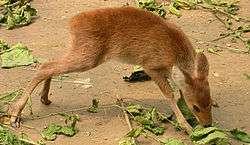

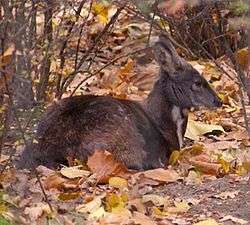
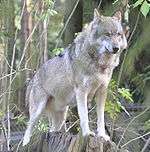

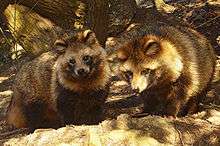


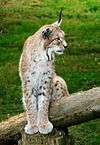
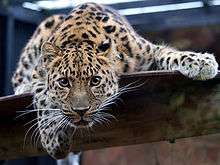



.png)

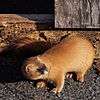


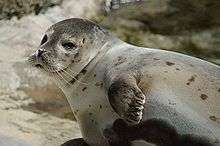
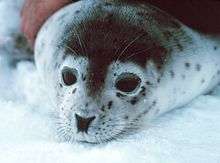







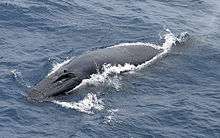





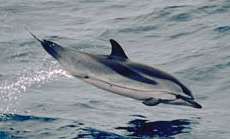





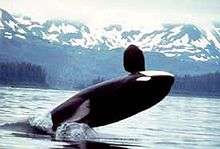



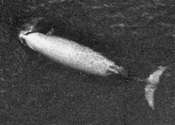
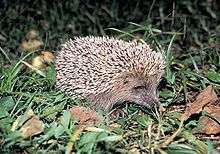


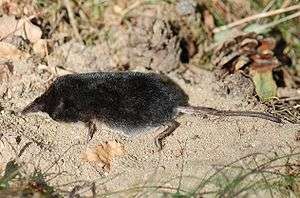





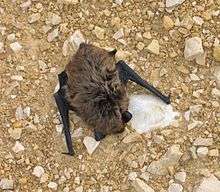
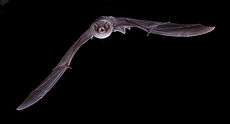
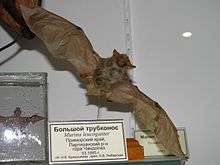

.jpg)






